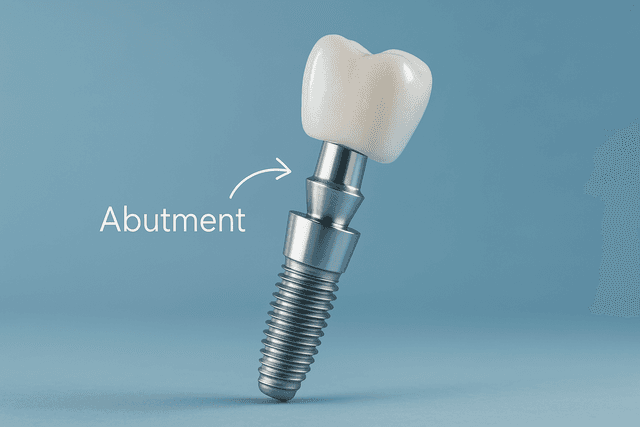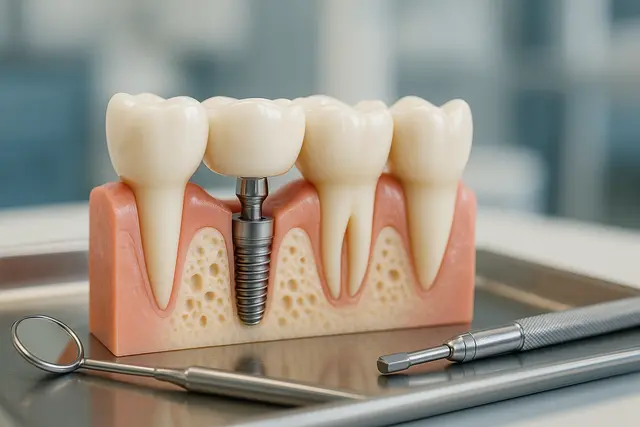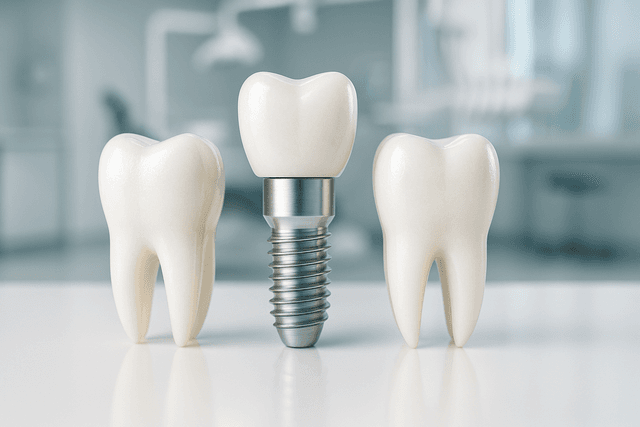Prosthodontics
5 min read
Oct 14, 2025
Caring for Implant Supported Bridges: How to Keep Them Strong and Healthy
Caring for your implant-supported bridge is just as important as getting it placed. These restorations are designed to look, feel, and function like natural teeth, but they need consistent care to stay that way. With the right cleaning habits and maintenance routine, you can protect your investment and keep your smile strong and healthy for years.

If you’ve invested in an implant-supported bridge, congratulations, you’ve taken a big step toward reclaiming your smile, your confidence, and your ability to chow down on apples without flinching. But just like with anything that makes your life better (a car, a dog, your favorite leather jacket), a little TLC goes a long way.
A dental restoration like this can last for years, possibly decades, with proper care. So, let’s talk about how to keep yours strong, sparkling, and functioning like a champ.
Implant Care Starts with Understanding Your Dental Bridge
An implant-supported bridges are anchored directly to the jawbone using implants rather than natural teeth. . Unlike traditional bridges that rely on adjacent natural teeth for support, implant-supported bridges are anchored directly to dental implants. These implants act like artificial roots, giving your bridge strength, stability, and that natural look and feel we all want.
Whether you’re replacing multiple missing teeth or upgrading from older dental work, this type of bridge offers a solution for replacing teeth that's more durable and better for your overall oral health. But here's the catch: the bridge is supported by implants rather than natural teeth, so the way you care for it is a little different than what you might be used to.
Floss the Right Way to Protect Your Implant Bridge
Let’s be real: flossing isn’t anyone’s favorite hobby. But when it comes to an implant-supported bridge, skipping it can lead to serious problems like gum disease or plaque buildup around the implant. Food particles love hiding under bridges, and your gums aren’t fans of that.
Using a floss threader or a water flosser makes the job easier. These tools help remove plaque and debris that like to party beneath your dental bridge. Some folks also swear by an interdental brush for getting into those tight spots. Just don’t jab at it like you’re scrubbing a pot, gentle is the name of the game here.
So, floss every day. Yes, every day. Your gums, implants, and future dental bills will thank you.
Brush with Care and a Soft-Bristled Toothbrush
You might think any ol' toothbrush will do, but not all brushes are created equal. Use a soft-bristled toothbrush to clean around the implant without scratching or irritating your gums. Brushing at least twice a day helps prevent plaque and tartar buildup, which can lead to gum disease and even implant failure.
Make sure to angle your brush slightly and get around the implant area with care. Don't forget the gumline. This isn’t just about shiny teeth, it’s about keeping the tissue around your implant-supported bridge healthy and strong.
Oral Hygiene Habits That Actually Work
You’ve probably heard “practice good oral hygiene” a thousand times. But what does that actually mean when it comes to an implant-supported bridge?
Here’s the short list:
Brush at least twice a day with a soft-bristled toothbrush
Floss daily using a floss threader or water flosser
Rinse with an antibacterial mouthwash to keep bacteria in check
Use an interdental brush for hard-to-reach spots
Avoid smoking, which increases the risk of implant failure
These steps aren’t just about keeping your implant bridge clean. They’re about protecting your investment and making sure your dental prosthetic stands the test of time.
Regular Dental Visits Make All the Difference
Even if you feel like your mouth is in tip-top shape, regular dental check-ups are a must. Your dentist can spot early signs of trouble like inflammation, gum recession, or unusual wear around the implant.
Routine dental visits also include professional cleanings, which help remove plaque and tartar buildup that your toothbrush might miss. Plus, your dental team can make sure your implant bridge is securely in place and hasn’t shifted.
Aim for cleanings and check-ups every six months, or more frequently if your dentist recommends it.
Implant-Supported Bridge Maintenance Is a Long-Term Commitment
We get it. Life gets busy. But your implant-supported bridge requires care and support that’s ongoing. The good news? Once you build the habit, it becomes second nature.
This type of dental work is designed for longevity, but only with proper care and maintenance. Unlike traditional bridges, which rely on adjacent teeth and can put strain on surrounding teeth, implants provide a stable foundation that helps preserve bone and support gum health.
Still, no bridge is indestructible. Grinding your teeth, skipping cleanings, or ignoring pain can all shorten the life of your dental restoration.
Watch Out for Buildup That Can Lead to Implant Failure
Plaque buildup may sound minor, but when it sets up camp around your implant, things can go south quickly. Without intervention, it can lead to gum inflammation, infection, and even implant failure.
Catch it early with good oral hygiene habits and regular cleanings. If you notice bleeding gums, persistent bad breath, or discomfort around the implant, don’t wait, see your dentist ASAP. Trust us, ignoring it won’t make it go away.
Boost Longevity with a Balanced Diet and Smart Habits
Yep, what you eat matters. Maintaining a balanced diet keeps your gums and bones strong, which helps support your dental implant. Go easy on super sticky or hard foods that can stress your bridge. Drink water often to flush away food particles and bacteria.
Also, avoid using your teeth as tools (no more tearing open chip bags with your molars), and consider wearing a nightguard if you grind your teeth. These simple choices can help your implant bridge last longer and perform better.
Dentistry That Supports Your Everyday Life
When done right, an implant-supported bridge is more than just a fix for missing teeth. It’s a way to bring back your confidence, your bite, and your peace of mind. But just like natural teeth, it needs attention and care to stay in top form.
At our practice, we’re dedicated to providing the kind of dental care that’s not only professional but personal. Whether you’ve just had your implant placement or you’re years into wearing your bridge, our team of dental professionals is here to support your journey. Because the success of your dental implant isn’t just about what happens in the chair, it’s about the care for dental implants you give it every single day.
How Should I Clean Around My Implant-Supported Bridge?
Cleaning around an implant-supported bridge requires more attention than traditional brushing. Use a soft-bristled toothbrush to brush twice daily, angling toward the gumline to clean around the implants. Flossing is essential, use a floss threader, super floss, or a water flosser to remove debris beneath the bridge. An interdental brush can also help clean tight spaces without irritating the gums. The goal is to prevent plaque buildup that could lead to gum inflammation or implant failure.
Why Are Regular Dental Check-Ups Important for Implant Bridges?
Routine dental check-ups, typically every six months, are crucial for spotting early warning signs of implant complications like inflammation, gum recession, or bridge instability. These visits allow for professional cleanings to remove plaque and tartar that brushing may miss, especially around implant-supported restorations. Your dentist will also assess the fit and condition of your bridge to ensure it remains secure and functional long-term.
What Lifestyle Habits Can Help My Implant Bridge Last Longer?
A balanced diet and smart habits play a big role in the longevity of your implant-supported bridge. Avoid hard or sticky foods that can stress the bridge, and don’t use your teeth as tools. Drink water regularly to wash away food particles and bacteria. If you grind your teeth, consider using a nightguard. Quitting smoking also significantly lowers the risk of implant failure, helping preserve your investment for years to come.
What Are the Signs That Something’s Wrong With My Implant Bridge?
Warning signs of trouble around your implant-supported bridge include bleeding gums, persistent bad breath, discomfort near the implant area, or the bridge feeling loose. These symptoms could indicate gum disease, infection, or implant failure. Addressing these issues early with a dental professional can often prevent more serious complications and help extend the life of your dental restoration.
Read Next
Related Posts

Prosthodontics
Implant Abutment Explained: What It Is and Why It Matters
Dental implants have revolutionized the way we restore missing teeth, but there's more to them than just the visible crown. One often-overlooked component, the implant abutment, plays a crucial role in both the function and appearance of the final result. Understanding what it is and why it matters can make all the difference in your implant journey.
4 min read
Oct 10, 2025

Prosthodontics
Pros and Cons of Implant Retained Bridges: A Simple, Honest Overview
Missing teeth can affect more than just your smile, they can impact your confidence, speech, and even how you eat. With so many options out there, it’s easy to feel lost in dental jargon and marketing buzzwords. That’s why we’re breaking down implant retained bridges in plain English, highlighting the pros and cons so you can make an informed choice without the fluff.
6 min read
Oct 10, 2025

Prosthodontics
Implant Crown Lifespan: What to Expect
Getting a dental implant crown is a big step toward restoring both function and confidence in your smile. But like any dental work, it's natural to wonder how long it will actually hold up. From materials and maintenance to daily habits, several factors play a role in how long your implant crown will last.
4 min read
Oct 10, 2025
Don’t have time to research every dentist around you?
See why 30k+ patients trusted us